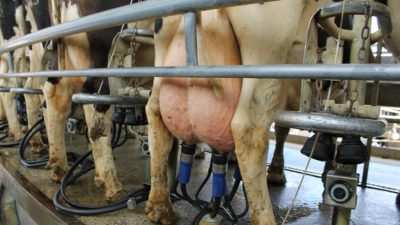Milk myths – a rebuttal

The dairy industry keep peddling the same lines in an effort to promote cow’s milk but we are not buying it and the research supports us.
An article published online by consumer group Which? on April 1 was sadly, I believe, no April fool’s joke. In attempting to debunk several so-called myths about cow’s milk, it simply served to reinforce the myths the failing dairy industry would have consumers believe.
Lactose intolerance
The article began by downplaying the prevalence of lactose intolerance, which is the normal state for most people. Around 75 per cent of the world’s population can’t digest lactose, the sugar in milk, beyond weaning. Why would you? Milk is, after all, baby food. Those who can digest lactose, can do so because they have inherited genes from their ancestors who began drinking milk around 6,000-8,000 years ago: this is very recent in terms of human evolution. The article suggests that milk is a good source of vitamin D, that’s incorrect. The NHS says: “In the UK, cow’s milk is generally not a good source of vitamin D because it is not fortified, as it is in some other countries.”
Fat facts
It says that milk is not a high fat food, as it contains less than five per cent fat; but it fails to consider that most of the fat in milk and dairy products is saturated. Even though low-fat milk products contain less fat overall, the fat in them is almost all saturated. This ‘bad’ fat is completely unnecessary for humans and increases the risk of heart disease and stroke, diabetes, metabolic syndrome and has been linked to several types of cancer. Some dairy products, such as cheese, are the biggest saturated fat contributors in Western diets, and have been blamed for the current obesity epidemic. Milk contains only tiny amounts of polyunsaturated fats that are essential for health and have a range of beneficial properties. These are abundant in plant foods and some plant milks are also a good source.
Cow’s milk and acne
The article claims that the links between milk and acne have not been studied in detail, but they have. Several worldwide observational studies have been published on dairy intake and acne. A recent review, published in the journal Nutrients, looked at 14 of these studies and concluded that: “Intake of any dairy, any milk, full-fat dairy, whole milk, low-fat/skim milk, and yogurt regardless of amount or frequency were associated with a higher odds ratio for acne compared to no intake in individuals aged 7-30 years.”
A cocktail of hormones
Regarding hormones, the article tries to downplay the natural hormone content of milk and uses a diversionary tactic – explaining how, in Europe, cows are not injected with bovine somatropin as they are in the US to increase milk production. Cow’s milk is designed to turn a 45kg calf into a 600kg cow in just over a year – so of course it is naturally packed with hormones and growth factors – no somatropin necessary! In addition, drinking milk triggers the endogenous (in our bodies) production of IGF-1, a growth hormone thought to increase the risk of some cancers. This may be the mechanism linking cow’s milk to cancers such as prostate cancer. Interestingly, a study published in the British Journal of Cancer found that vegans had lower levels of IGF-1 in their blood. Professor Jeff Holly, an IGF-1 researcher at the University of Bristol says: “Milk was designed to be consumed by infants before they are weaned, when the body’s tissues are growing faster than at any other time in life. You are designed to grow until your bones fuse at puberty, so stimulating growth at that time makes a lot of sense. After that, you don’t want to be stimulating tissues to grow.”
Pus in milk
Then on to the sticky subject of pus in milk. The idea that milk contains pus isn’t accurate, says the article. However, it admits that milk does contain white blood cells – a component of pus, along with cellular debris and necrotic (dead) tissue. The dairy industry doesn’t like people using the word ‘pus’ much preferring ‘white blood cells’ which are naturally present in milk and can be taken as an indicator of disease – the higher the level, the higher the level of infection. In the UK recent research found that, on average, there are between 50 and 70 cases of mastitis (infection of the udder) per 100 cows per year. The industry uses a ‘somatic cell count’ to measure the number of white blood cells in milk as an indicator of this type of infection. In the UK, a limit of 400,000 cells per ml are permitted, above which milk can’t be sold for human consumption. So, one teaspoonful of milk could contain up to two million pus cells! The article claims that low levels of white blood cells indicate that cows are healthy. I’m not sure I would equate the absence of infection with being healthy. Talk about spin!
Antibiotics
Regarding antibiotics, the article refutes that milk containing antibiotics is sold in the UK. That may be broadly true, but the use of antibiotics in livestock to prevent disease (such as mastitis) continues in the UK and contributes to the rise of antibiotic-resistant superbugs. The UK government says: “As in humans, the sub-optimal use of antimicrobials in agriculture and veterinary practice contributes to the rise and spread of AMR [antimicrobial resistance] all over the world.”
Nutrients
All the usual candidates are rolled out in this article; protein, calcium, vitamin B12, iodine etc. It says milk provides better quality protein, but recent evidence says this idea of ‘complete protein’ is outdated and providing your diet is varied and provides enough calories, you will get plenty of protein. Writing in the journal Nutrients, scientists said: “The claim that certain plant foods are “missing” specific amino acids is demonstrably false.” Many plant milks are fortified with calcium and vitamin B12 and some contain iodine too. The dairy industry tries to persuade people to consume dairy products on the basis that milk contains iodine. However, it is not a natural component of milk, it comes from iodine supplements in cattle feed and iodine-containing disinfectant used to sterilise milking equipment and added to teat dips and udder washes! Similarly, vitamin B12 is fed to livestock as a supplement. So, whether you consume plant milk or cow’s milk, these nutrients are added to it, rather than naturally occurring.
Confusion
Consumers are confused by conflicting advice, all too often coming from industry-funded studies and articles. The British Nutrition Foundation (employer of one of this article’s much-quoted ‘experts’) promotes itself as a source of impartial information, but as journalist Phil Chamberlain reported in the British Medical Journal, it does not always make its links with industry clear.
Drinking milk beyond weaning (and from another species too!) is neither normal or natural. You probably wouldn’t suckle from a dog or a cat, but what’s the difference? Peddling the myths that we need cow’s milk for good health is at best irresponsible and misleading.
Find out more here.





